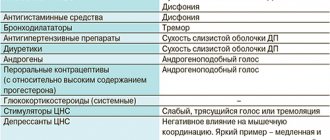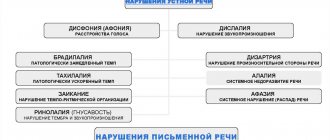Consultation with a speech therapist “Voice impairment”
Alena Popova
Consultation with a speech therapist “Voice impairment”
Question 1
Voice disorders . Definition, etiology, classification
Voice disorders are the absence or disorder of phonation due to pathological changes in the vocal apparatus . The following researchers were involved: Malyutin, Ermolaev, Fomichev, Taptapova, Lavrova, Almazova,
The voice is a collection of various sounds resulting from the vibration of elastic vocal folds .
The sound of a voice is the vibration of air particles, propagating in the form of waves of condensation and rarefaction.
The pitch of the sound is determined by the frequency of the oscillatory movements: the more often the periodic vibrations of the air occur, the higher the sound.
Timbre - or the color of sound - reflects the acoustic composition of complex sounds and depends on the frequency and strength of vibrations.
Resonance is a sharp increase in the amplitude of vibrations that occurs when the frequency of vibrations of an external force coincides with the frequency of natural vibrations of the system. There are two main resonators - head and chest .
Optimal conditions for the function of the vocal apparatus appear when a certain resistance is created in the supraglottic cavities to portions of subglottic air that passes through the vibrating vocal folds . This resistance is called impedance; when it is created, the vocal folds work with low energy consumption and good acoustic effect. This is a protective function of the body
There are two main ones. voice pathology : aphonia - complete absence of voice and dysphonia - partial disturbances of pitch , strength and timbre.
voice pathology and methods for its restoration is one of the problems of speech therapy . Phonopedia is a complex of pedagogical influences aimed at the gradual activation and coordination of the neuromuscular apparatus of the larynx with special exercises, correction of breathing and the student’s personality.
Voice disorders are divided into central and peripheral, each of them can be organic and functional. Sometimes voice disorders can be an independent manifestation, and sometimes they are part of the structure of the defect in aphasia, dysarthria, rhinolalia, and stuttering. The mechanism of voice disorders depends on the nature of changes in the neuromuscular apparatus of the larynx, primarily on the mobility and tone of the vocal folds , which usually manifests itself in the form of hypo or hypertonicity, less often in a combination of both. Causes of voice disorders in children :
— biological ( constitutional characteristics , age, gender, concomitant diseases);
- household (marital status, family composition, living conditions)
; — psychological (conflict situations, domestic and professional; psycho-emotional, personality traits).
Classification of voice :
1. Functional voice disorders
central (psychogenic aphonia or hysterical mutism, dysphonia in neuroses)
peripheral (phonasthenia, hypotonic and hypertonic dysphonia or aphonia, pathological mutation, dysphonia due to vocal )
2. Organic voice disorders
central (dysphonia and aphonia with dysarthria and anarthria)
peripheral (larynx injuries, laryngitis, rhinolalia, rhinophonia, dysphonia with hearing loss).
Hysterical mutism is an immediate loss of voice , most often in neurotic people with a psychogenic etiology;
Phonasthenia - vocal weakness or rapid exhaustion of the voice ;
The presentation the voice great importance Three types of vocal delivery : 1. First there is a slight exhalation, then the vocal folds close and begin to vibrate. The voice sounds after a slight noise - an aspirated attack 2. the moment of closing of the vocal folds and the beginning of exhalation coincide - this is a soft attack. 3. First, the vocal folds , and then the vocal folds are realized. exhale, causing them to oscillate - a solid attack. The most physiologically based soft attack.
Question 3
Organic voice , etiology, mechanisms, symptoms
Voice disorders are the absence or disorder of phonation due to pathological changes in the vocal apparatus . The following researchers were involved: Malyutin, Ermolaev, Fomichev, Taptapova, Lavrova,
Organic voice disorders Voice pathology that occurs as a result of anatomical changes or chronic inflammatory processes of the vocal apparatus is considered organic. Peripheral organic disorders include dysphonia , and aphonia in chronic laryngitis, paresis and paralysis of the larynx, conditions after tumor removal. voice defect depends not on the type of disease, but on its severity. Chronic laryngitis is very diverse. This manifests itself in characteristic changes in the mucous membrane of the larynx, and subsequently in damage to its neuromuscular system. The emerging non-closure of the vocal folds leads to a persistent voice and is accompanied by subjective unpleasant sensations in the pharynx and larynx. The voice loses its normal sound, severe fatigue appears to the point of complete inability to perform vocal work . Voice disorders caused by peripheral paresis and paralysis of the larynx occur due to trauma or infection of the lower laryngeal or recurrent nerve. More common are unilateral violations . The position of the vocal fold on the affected side can be median (medial, lateral (lateral)
and the average between those indicated
(intermedial)
.
In the lateral position voice ; in the medial position, the breathing defect is more pronounced. Impaired motor function of the larynx leads to neurogenic paresis of the internal muscles on the affected side, which in this case are considered organic.
The voice is absent or sharply hoarse, complaints of severe fatigue when speaking, choking, reflex cough, difficulty breathing. voice formation occurs . The combination of a severe voice with breathing disorder makes the disorder especially severe . Organic central voice disorders include central paresis and paralysis of the larynx, depending on damage to the cerebral , pons, medulla oblongata, and pathways. In children they occur with cerebral palsy.
Often the cause of organic voice disorders is tumors and conditions after their removal. Benign tumors occur in children and adults more often than malignant ones. Vocal pathology when the tumor is localized on the vocal folds develops gradually as it grows. Multiple papillomas are more often observed in children; they can spread throughout the entire larynx and recur after removal. Extensive papillomatosis and scar changes after multiple operations cause severe breathing and voice disorders .
The etiology and pathogenesis of this disease have not yet been disclosed. Early papillomatosis with impaired respiratory and vocal functions can negatively affect the formation of the child’s entire speech and personality. Insufficiency of the vocal apparatus appears after the most gentle removal of the tumor. Complete removal of the larynx due to a malignant tumor deprives a person of his voice and sharply impairs respiratory function , since the trachea is separated from the pharynx. All of the above-described voice disorders are chronic and do not disappear on their own. Spontaneous development of the defect is always negative. Voice disorders , as a rule, do not affect the formation of the speech system. Only particularly severe pathology at an early age has a negative effect on speech development. This is sometimes observed in children with multiple papillomas and cicatricial stenoses of the larynx, if the disease began before the formation of speech. SYMPTOMATICS IN CHILDREN. Repeated operations, impaired breathing through natural pathways in the absence of a voice cause somatic weakening of the child and can cause delayed mental development and speech, deviations in the emotional-volitional sphere. Children feel inferior, become withdrawn, unbalanced, capricious, and have difficulty making contact. They have difficulty mastering correct sound pronunciation, their vocabulary is poor, which affects the success of their studies at school. Such complicated cases are more common in dysfunctional families, where children are not given due attention. In milder cases of voice disorder, children are calm about their condition. Some of them are critically aware of the defect and strive to eliminate it. Others do not hear themselves and remain indifferent to the distorted voice .
ADULTS, regardless of the degree of the defect, have a hard time experiencing voice disorders . Several reasons can be identified that determine the severity of these experiences. One of them is personality traits. Persons with a labile nervous system have a more depressed mood and lack faith in the possibility of overcoming the defect. The second reason is an incorrect assessment of your condition. Many people believe that paralysis and the consequences of tumor removal are irreversible. The third psychologically traumatic cause is the duration of the voice and the repetition of insufficiently effective treatment. Finally, one of the main reasons is the role of voice in work activity. Long-term voice impairment creates a threat of professional unsuitability, which, with some predisposition and asthenic factors, leads to the development of a neurotic state. There is a fear of public speaking, general fatigue, self-doubt, anxiety, insomnia, and low mood. Organic voice disorders
:A. For acute chronic laryngitis.
Clinical picture: vibrations of the vocal folds are uneven, both in amplitude and frequency. The movements of the folds are weakened.
B. Voice impairment with marginal and unilateral chorditis is inflammation of one fold. It is manifested by swelling and hyperemia of the free edge of the vocal fold , due to which its vibrations are weakened.
B. Vocal fold .
Reason: incorrect vocal . Excessively active closure of the vocal folds and a forced, firm attack of the voice . In childhood, it is more often observed in boys (ratio 3 to 1)
at the age of 5-10 years
(they are also called screamer knots)
.
In adults, they are more often observed in women aged 20 to 50 years (about 40 times more often than in men)
Clinical picture: nodules are microscopic changes in the mucous membrane arising in the anterior third
vocal folds , the so-called "nodular zone"
.
Vibrations of the vocal folds are usually preserved. Less often, in (14%)
cases, they are absent, while
the vocal folds are adducted and tense, touching in the area of the nodules, symmetrically located on the folds opposite each other. Hourglass-shaped gaps remain between other sections of the folds. Fluctuations of the folds are often uniform, but with a weakened amplitude. External manifestations: hoarseness, hoarseness of voice .
D. Vocal fold polyps are single formations on the vocal folds , located only on one side. Their removal is not possible through speech therapy and requires neurosurgical intervention.
Polyps have a smooth spherical shape, attached either at a wide base or on a thin stalk. In the latter cases, during the process of voice formation , the polyp moves in the larynx, and patients complain of the sensation of a foreign body in the larynx. Polyps are more often diagnosed in men, but there is no significant discrepancy with their prevalence in women.
Laryngeal papillomatosis is a benign tumor of the larynx that causes voice disturbance in the form of dysphonia , aphonia. Externally it is a large warty formation. Most often occurs in children aged 2 to 4 years. Some attribute this to a viral disease, others attribute it to immunodeficiency.
E. Paresis and paralysis of the larynx.
Voice impairment is caused in this case by organic insufficiency of innervation of the muscles of the vocal apparatus . The consequence of this is the limitation of their mobility. This can occur on both sides or affect only one vocal fold . Occurs in dysarthric disorders.
Voice disturbance in case of scar stenoses (narrowing of the larynx due to burns, injuries, operations)
leading to
impaired mobility of the larynx .
Question 4
A comprehensive method for eliminating voice
Restoration of organic voice disorders Voice restoration must begin as early as possible. This prevents the fixation of the skill of pathological voice production and the appearance of neurotic reactions. 1 task - identifying the compensatory capabilities of the body 2. Task - eliminating the pathological method of voice production . To implement the tasks it is necessary: 1. activation of the function of the neuromuscular apparatus of the larynx 2. prevention of the development of secondary defects of the vocal apparatus . 3. positive impact on the student’s personality to eliminate psychogenic reactions. 4. restoration of lost kinesthesia of voice guidance etc. directly to the phonation itself. 5. Restoring coordination of breathing and phonation Stages of work:
1. Rational psychotherapy
2. Correction of physiological and phonation breathing
3. Training of kinesthesia and coordination of the vocal apparatus with phonopedic exercises. Phonopedia is a complex of pedagogical influences aimed at activating and coordinating the neuromuscular apparatus of the larynx with special exercises, correcting breathing and personality
4. Automation of restored phonation
Voice restoration with paresis and paralysis of the larynx Work on breathing (stage 2)
begins after psychotherapeutic preparation
(stage 1)
.
With lesions of the inferior laryngeal nerve, the motor function of the larynx is sharply limited, and the vocal fold on the affected side is completely immobile. Simultaneously with phonation, physiological and phonation breathing suffers. This is especially pronounced in the medial position (middle position
of the vocal fold ) . It is impossible to restore the motor function of the larynx with paralysis. We connect compensation. capabilities of the body.
Required max. increase the mobility of the healthy half of the larynx, and partially restore motor function on the paralyzed side. Particularly important is the normalization of physiological and phonation breathing, which will cause closure of the vocal folds due to the compensatory transition of the healthy half of the larynx beyond the midline and bringing it closer to the stationary half of the larynx. This your voice significantly. Exercises “Blowing a harmonica”
, gradually increasing the load. Simultaneously with such exercises, a set of breathing exercises is performed that trains directed, extended exhalation.
As a result of training, the reflex cough disappears, the sensation of foreign matter in the throat disappears, and weak oscillatory movements of the paralysis appear. folds. (3rd stage)
voice exercises for training kinesthesia and coordination of the vocal apparatus . We continue breathing exercises. voice correction by pronouncing the sound M - this is the best basis for establishing the correct phonation. Then we move on to pronouncing the open syllables MA , MO, MU, ME, WE., then the kinesthesia of voice guidance when pronouncing pairs of syllables with emphasis on the second syllable: MA-MA, NA-NU, etc. Then we train the combination of vowels with Y - OH, OH. Upon completion of work on sound and syllabic exercises . We begin automation of the restored voice (stage 4)
.
Voice restoration in chronic laryngitis
Medication and physiotherapeutic treatment is required. We start with a conversation. We observe a protective regime: reducing vocal load , forcing the voice .
Stage 1. Working on breathing. We exhale and pronounce the voiceless consonants S, Ш
Stage 2 neck massage in the larynx area.
Stage 3 fight against cough - pronounce silent Y.
4. Stage of carrying out physical therapy.
5. Let's move on to voice exercises . voice production are the same as for paresis and paralysis. Pronouncing M is easier and faster.
Colds must be avoided
Voice restoration after removal of the larynx
Removal (extirpation)
of the larynx due to a malignant tumor
disrupts the natural respiratory tract and completely deprives the voice while the articulatory apparatus and neurophysiological mechanisms of speech are intact.
It is necessary to work with a psychotherapist. It is necessary to create a compensatory organ - narrowing at the level
4-6 cervical vertebrae, called pseudogap. formed in this way is called esophageal . The method of forming the esophageal voice belongs to Taptapova.
Stage 1 – psychotherapy and training in breathing through a tracheostomy – an opening in the larynx after surgery
Stage 2 – formation of the pseudoglottis and induction of the esophageal voice with the help of special exercises.
Stage 3 – automation of the esophageal voice , pronouncing short phrases
Stage 4 - use of vocal exercises.
Voice restoration in children with organic changes in the larynx When papillomas are removed and cicatricial changes in the larynx appear. Correction of breathing, sound pronunciation and voice . Correction of sounds is carried out using generally accepted techniques in parallel with work on the voice . Evoking a voice in a child with aphonia with scarred changes in the larynx is the most difficult moment in correctional classes. Any voiced consonant sound is selected individually. More often M and F when “moaning”
and
"mooing"
or
"buzzing"
. They use auditory and vibration-tactile control.
Restoration of functional voice disorders To restore normal voice . appart. When phonation occurs, it is necessary to find out the cause. Phonopedic exercises are necessary: lengthening the phonation exhalation, finding a position convenient for speaking . It is found when pronouncing the sound M for a long time. You can use a tuning fork. For this, a tuning fork that sounds appropriate. the pitch of the voice is applied to the crown of the head and the voice, as it were, adjusts to its sound. This helps to find and consolidate the correct kinesthesia of voice guidance .
When restoring the voice in case of hypo- and hypertonicity disorders , work on breathing, activate the vocal apparatus in case of hypotonicity and relieve excess tension. with hypertension. For hypertonic disorders, first use . inhalation attack of sound (light exhalation, then closing and vibration of the vocal folds ) during breathing exercises, massage of the anterior surface is performed. Necks. Then we learn to pronounce the sound M from a groan. It is better to sound K as a cough impulse. During restorative treatment, technical means are used: Strakhov devices, which improve the timbre and strength of the voice .
Question 2
Functional voice , etiology, mechanisms, symptoms.
Voice disorders are the absence or disorder of phonation due to pathological changes in the vocal apparatus . The following researchers were involved: Malyutin, Ermolaev, Fomichev, Taptapova, Lavrova,
The most common and diverse are functional voice disorders . They are not accompanied by inflammatory or anatomical changes in the larynx. With functional voice disorders, the activity of the vocal apparatus is disrupted in the absence of organic damage.
The causes of functional pathology are very different: vocal fatigue voice production , various infectious diseases and the influence of mental factors. Long lasting functions. changes can cause pseudoorganic deposits in the form of hyperemia (redness)
mucous membrane of the larynx, thickening of
the vocal folds , which can complicate the diagnosis of functional disorders .
Functional voice disorders are divided into central and peripheral.
Peripheral: phonasthenia, hypo and hypertonic aphonia and dysphonia.
Phonasthenia - vocal weakness or rapid exhaustion of the voice ;
dysphonia – partial disturbances of pitch , strength and timbre. aphonia – complete absence of voice
Phonasthenia - in the initial stages is not accompanied by visible objective changes in the vocal apparatus . It is of a professional nature and develops in people of voice professions . It manifests itself in: impaired coordination of breathing and phonation, inability to control the voice - to strengthen and weaken the sound, the appearance of detonation. Acute forms turn into aphonia.
Hypotonic dysphonia (aphonia)
caused by bilateral myopathic paresis, i.e. paresis of the internal muscles of the larynx.
They occur with certain infections (ARVI, influenza, diphtheria, as well as with severe voice the vocal folds suffer . With hypotonicity, the vocal folds do not completely close at the time of phonation, there is a gap between them. External manifestations: voice , hoarseness, decreased strength voices ...
These phenomena are more often observed in women. Clinical picture: during laryngostroboscopy, vibrations of small and medium amplitude predominate, incomplete closure of the glottis with a distance of up to 2-4 mm. The glottis has the shape of an oval, less often a triangle.
Hypertonic dysphonia
Reason: may be associated with an increase in the tone of the laryngeal muscles with a predominance of tonic spasm at the time of phonation. the use of a solid attack of vocal production and an extremely loud voice , which results in an increase in the tone of the vocal folds . In general, it is less common than hypotonic dysphonia and is observed mainly in men. External manifestations: complaints of pain in the larynx, neck, desire to cough, voice , hoarseness, periodic spasms.
The voice either does not arise at all or a sharply distorted dull sound appears. This is often combined with tension in the muscles of the face, neck, swelling of the veins in the neck. Clinical picture: during vocal production, the vocal folds sharply come into contact with each other, resulting in hyperemia (redness)
and swelling of their free edge. With laryngostroboscopy in 60% of cases
the vocal folds look motionless and are in a tense, closed state. Sometimes, such immobility is combined with periods of rapidly fading oscillatory movements with small amplitude.
Hypo-hypertonic dysphonia
Reason: more often observed after acute laryngitis, tracheitis, laryngeal papillomatosis, when the vestibular folds (false, and the vocal voice formation of the vocal folds and an increased tone of the vestibular folds.
External manifestations: a sharp, hoarse sound of the voice , a monotonous sound is called a false voice.
Clinical picture: the vestibular folds are usually enlarged in size, sometimes hyperemic, and during the process of voice formation they come into contact with each other, overlapping the vocal folds . The vibration of the vocal folds is weakened , with incomplete closure of the glottis
Central: Functional voice disorders of central origin include functional or psychogenic aphonia
Reason: most often a stressful state (fear, conflict with parents, teachers, peers)
this is
a “trigger”
leading to complete loss
of voice . It is typical for people with a hysterical reaction, most often in girls and women. External manifestations: a person can communicate only in a whisper, while laughter, crying, and coughing remain intact, which is a possible diagnostic sign. The voice can either suddenly disappear or appear spontaneously.
Symptoms
The forms of manifestation of aphonia and dysphonia help determine the nature of speech disorders and suggest the mechanism of their occurrence.
So, with organic disorders, speech disorder manifests itself as follows:
- discomfort in the larynx, pain when speaking; fatigue, reflex cough, incoordination of speech and breathing - all this indicates laryngeal paresis;
- increasing voice disturbances often indicate progressive neoplasms;
- In children, incorrect phonation is accompanied by developmental delays and difficulties in establishing contacts due to the underdeveloped speaking function.
With functional disorders, the following picture develops:
- lack of control over the tempo and volume of speech, which passes when the voice regime is observed;
- signs of laryngeal spasms include pain in the back of the head, neck, and whispered speech;
- a sudden loss of voice, despite the fact that the ability to produce loud sounds when coughing and laughing, remains a symptom of hysterical mutism.
The structure of the speech apparatus, its ability to function
How does sound formation occur in humans, and why can we pronounce individual words, sentences, texts? Speech sounds and their combinations are produced as a result of contraction of the muscles of the peripheral speech apparatus. When a person inhales, the created air flow enters the larynx, creating nerve impulses that in turn affect the vocal cords. Sound production occurs due to the vibration of the vocal cords, that is, they are the main speech instrument in humans, but far from the only one.
Content:
- The structure of the speech apparatus, its ability to function
- Causes of voice loss: why pathology is formed
- Types of aphonia known to medicine
- Diagnosis, recommendations and treatment of aphonia problems
The entire vocal apparatus consists of a central and executive department. The first is the brain: the cerebral cortex, subcortical structures, brainstem nuclei, nerves, pathways. The peripheral or executive department is a system of speech organs consisting of bones, cartilage, muscles, ligaments and peripheral nerves that contribute to the work of these organs in the process of creating and extracting sounds.
The peripheral speech apparatus is divided into the respiratory section (lungs, trachea, bronchi, diaphragm and intercostal muscles), the vocal section (ligaments), and the articulatory section (it is also called sound-producing: soft palate, lips, tongue, lower jaw, teeth, nasal cavity, pharynx , larynx, hard palate).
Each of the listed organs participates in a well-coordinated mechanism for extracting sounds and giving them a certain sound. For example, the strength, timbre and pitch of the voice depend on the movement of the air flow on the ligaments, on its strength and direction. The articulatory organs are responsible for the nature of pronounced sounds, the fullness of vowels, the hardness and clarity of consonant sounds.
Diagnostics
An otolaryngologist, a neurologist and a phoniatrist take part in the search for the causes of voice disorders. The first examines, refers to laryngoscopy, the second studies the nature of the activity of the central nervous system, conducts electromyography if necessary, and the phoniatrist prescribes stroboscopy - an examination of the vocal cords under load.
The speech therapist’s task is to study the nature of speech sounds, for which he analyzes the voice using a diagnostic map of disorders. Speech therapy diagnostics is an assessment of the characteristics of phonation and physiological breathing, the study of the voice formation algorithm. If there is an assumption about the development of tumor neoplasms, a computed tomogram is required.
Correction
Planning of corrective measures includes 4 components:
- drug therapy aimed at eliminating inflammation and regenerating the mucous membranes of the larynx;
- for ENT pathologies of an organic nature - surgical intervention; restorative treatment in the form of massage, physical therapy,
- physiotherapeutic activities;
- Speech therapy: for voice disorders, speech therapy sessions are prescribed as early as possible. This is to prevent pathological vocalization from taking root. Orlova describes in detail the forms of correcting voice disorders.
Speech therapy tasks are very broad. For example, in patients with a removed larynx, the skill of speaking through the esophagus is developed. The specialist also helps relieve tension associated with speech defects, which helps to avoid neuroticism of the phonation symptom. An important role is played by the help of a psychologist, whose tasks include identifying the trigger mechanism for the formation of hysterical mutism.








